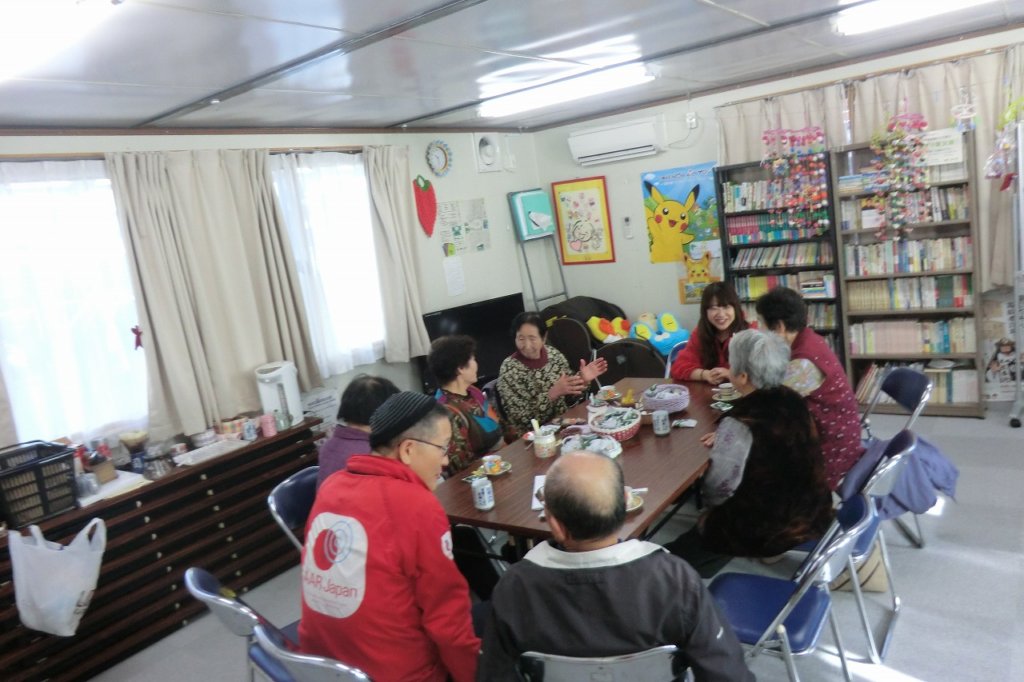By Yuko Ito | Programme Coordinator
It has been almost four years since the 3.11 disaster struck Tohoku Region in Japan. In the disaster stricken areas, some rehabilitation and reconstruction progress can be seen. For instance, new public restoration apartments have been constructed. Some people have already moved out of temporary housing complexes on their own. On the other hand, there are those who drew a losing ticket for public housing allocation and are waiting for construction of other public restoration apartments, as well as those who are hesitative about moving to public housing due to concerns about monthly rent payment (temporary housing residents do not need to pay rent).
Many of the residents at temporary housing complexes are elderly, and it is difficult for them to reconstruct house on their own, and to leave their hometown and join a new community. As such they tend to live alone in a temporary housing complex. Further, alcohol dependence is prevalent among those with a dismal outlook after losing a job to the earthquake or nuclear power plant accident, or those who cannot free themselves from much sorrow over the loss of family members and friends.
In response, AAR Japan has conducted a variety of events under “Building Health Communities Project” to prevent deterioration of physical and psychological well-being and to promote communication within temporary housing complexes in Iwate, Miyagi, and Fukushima Prefectures. In Tohoku Region, many people are reticent and reserved, and tend not to open up to outsiders. Knowing these characteristics of Tohoku people, AAR has regularly visited same temporary housing complexes to gain their trust with time and care.
This is a report from one of those temporary housing complexes in Watari Town, Miyagi Prefecture. 306 lives were lost to the 3.11 earthquake and tsunami, and 3,733 houses were destroyed or damaged in the town. AAR has been assisting Watari Town since the occurrence of the disaster, and has visited the featured temporary housing 13 times (as of the end of January, 2014).
On December 14th, 2014, AAR staff and a counselor visited the temporary housing complex. It was a cold day with snow piled on the ground. Despite the weather, a total of 16 residents gathered in the meeting hall to participate in a recreational activity to make mini Christmas trees using a pine cone. As a prior notice was disseminated among the residents, many looked forward to the event. The participants concentrated on the task of delicately putting beads on a pine cone. Towards the end of the activity, the participants started to discuss a variety of topics including daily lives at the temporary housing (life rhythm, handicrafts that they made), the prospect of their new house (anxiety and relief about moving into a new house), and their health (tips for cold prevention and care for maintain their physique).
At the beginning of the activity, however, it seemed that a sense of unity was lacking in the temporary housing complex. It was probably because the residents came from several different communities in Watari Town, and they separated themselves into small community groups. Nonetheless, once mini Christmas trees were made, the walls between the groups broke down. They enjoyed interacting with each other. After the activity that required much concentration, we ended the day with calisthenics.
When everyone was almost finished with the mini Christmas tree making, a lady in her 80s approached an AAR staff member, and started to talk about her experience of the day the disaster struck. “Immediately after the earthquake, I asked the company president if I could go home”, she recalled. “That was the right judgment call. My colleagues who stayed at work passed away… I survived, but I only had clothes I was wearing, and everything else was washed away. Not even a picture is left. It’s sad.” She continued, “I can’t fit in this temporary housing complex where most people are from different communities. All the houses are so close to each other, and I feel like my neighbors are peeping in my house. This had never happened to where I used to live. I’m fed up with living in this cramped cave.”
Although almost four years has passed, and many people lived in the same complex, there are still those who isolate themselves from their neighbors. Those people do not have anyone or any opportunities to talk about their feelings and bitter experience of the disaster. Some pour out their feelings when AAR visits the temporary housing complexes. It is not easy to assuage someone’s grief over loss of not only friends and family, but also livelihood and hometown. What we can do is to be with the survivors’ hearts and offer those who isolate themselves opportunities to interact with others. Four years since the disaster, such psychosocial care is still needed. AAR will continue to provide the survivors with psychosocial care through Building Healthy Communities Project.
Project reports on GlobalGiving are posted directly to globalgiving.org by Project Leaders as they are completed, generally every 3-4 months. To protect the integrity of these documents, GlobalGiving does not alter them; therefore you may find some language or formatting issues.
If you donate to this project or have donated to this project, you can receive an email when this project posts a report. You can also subscribe for reports without donating.



